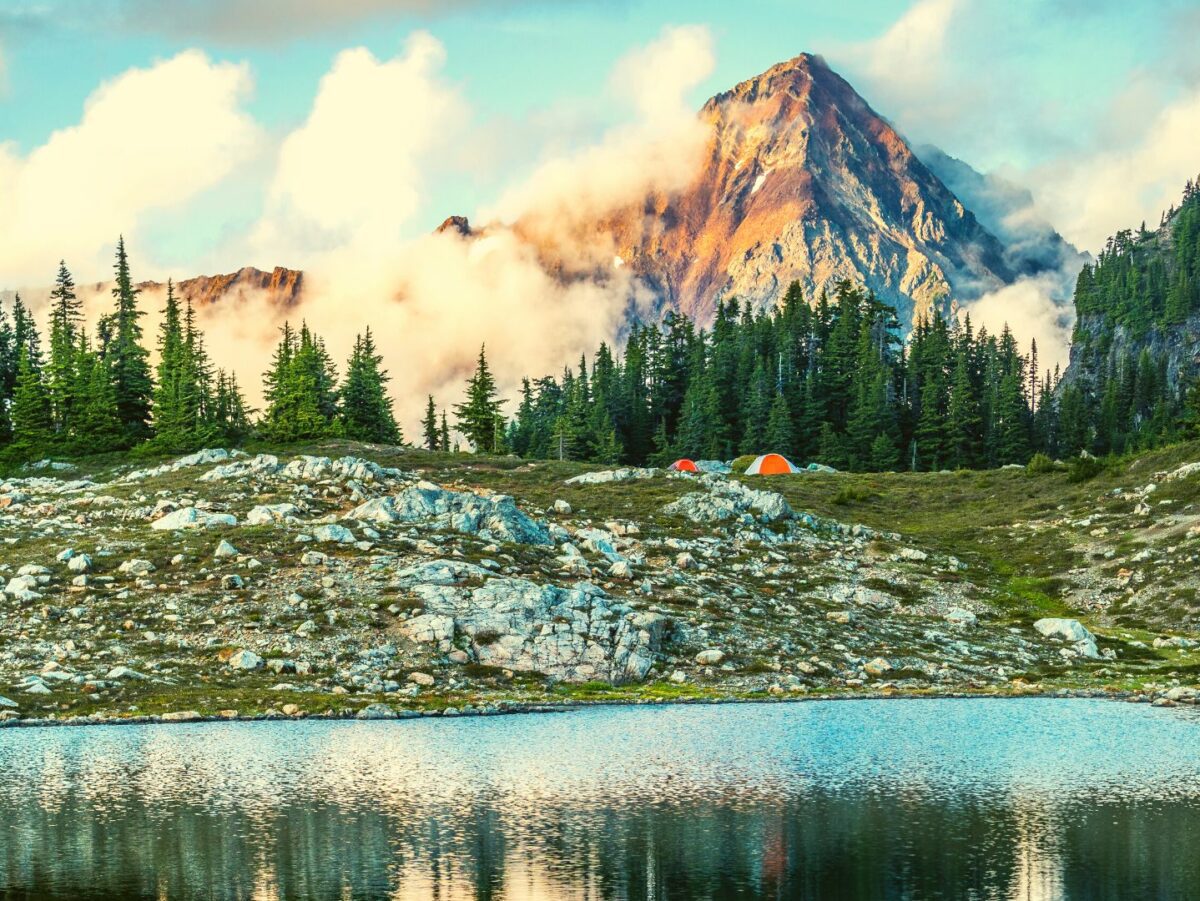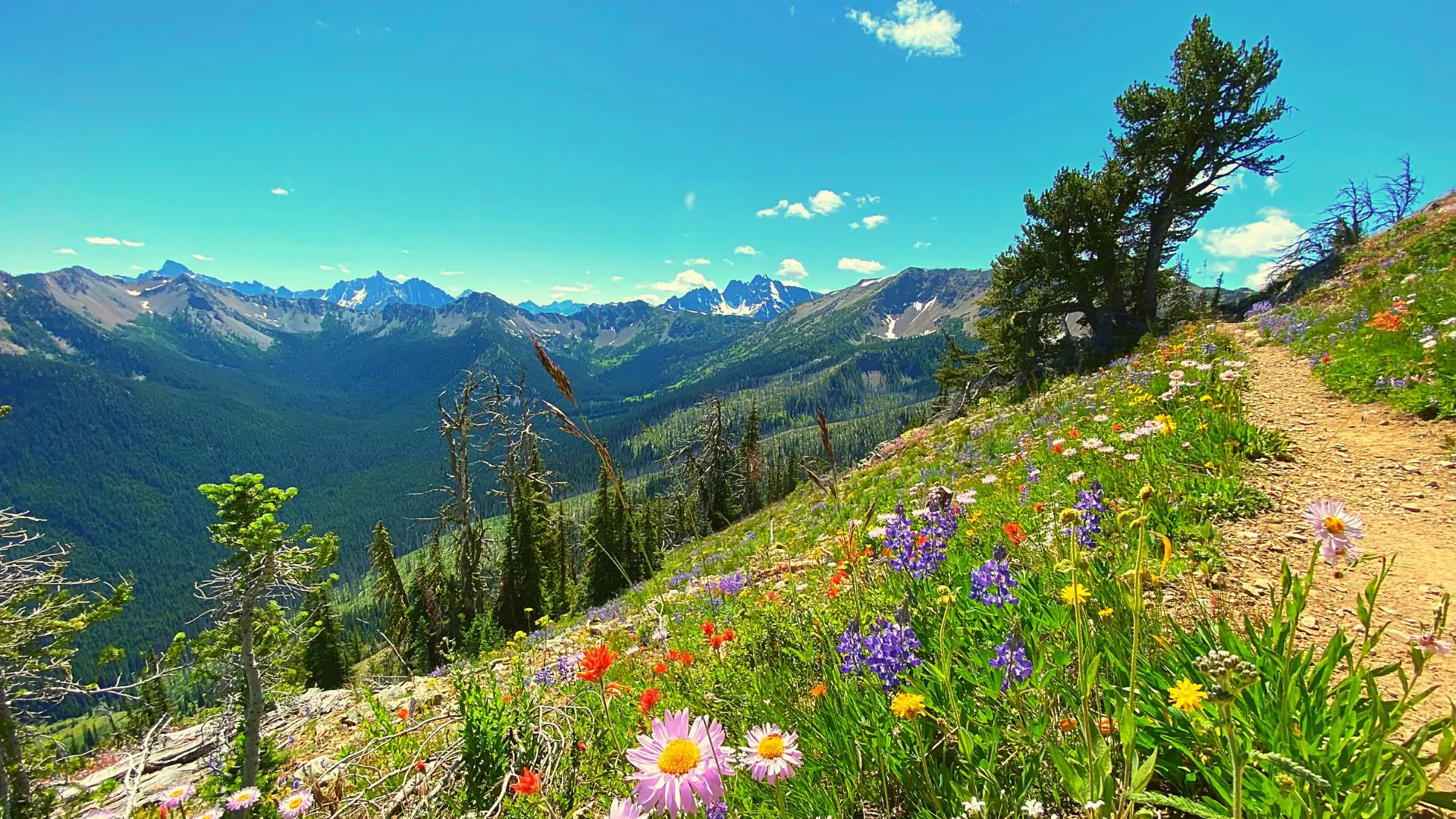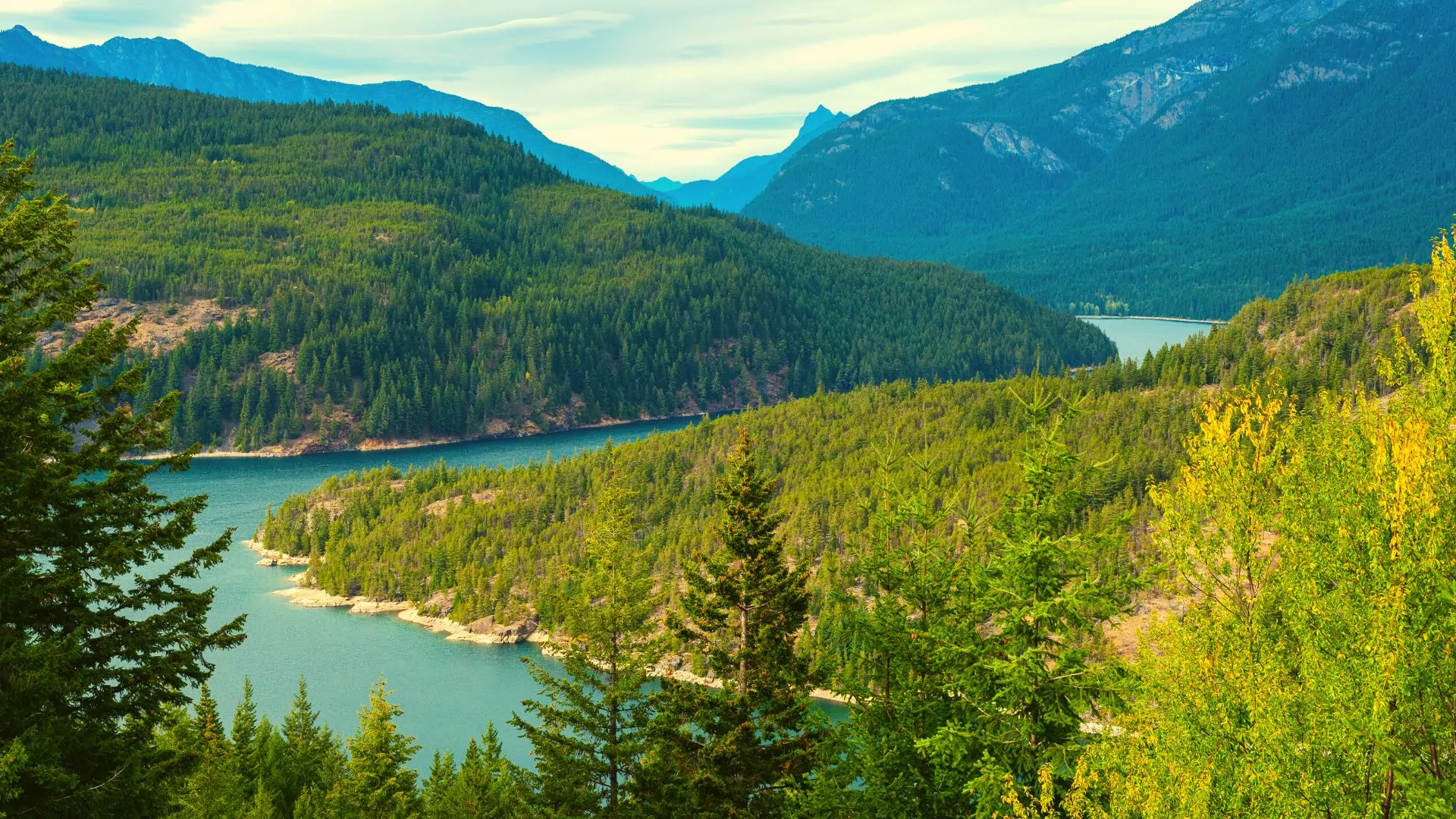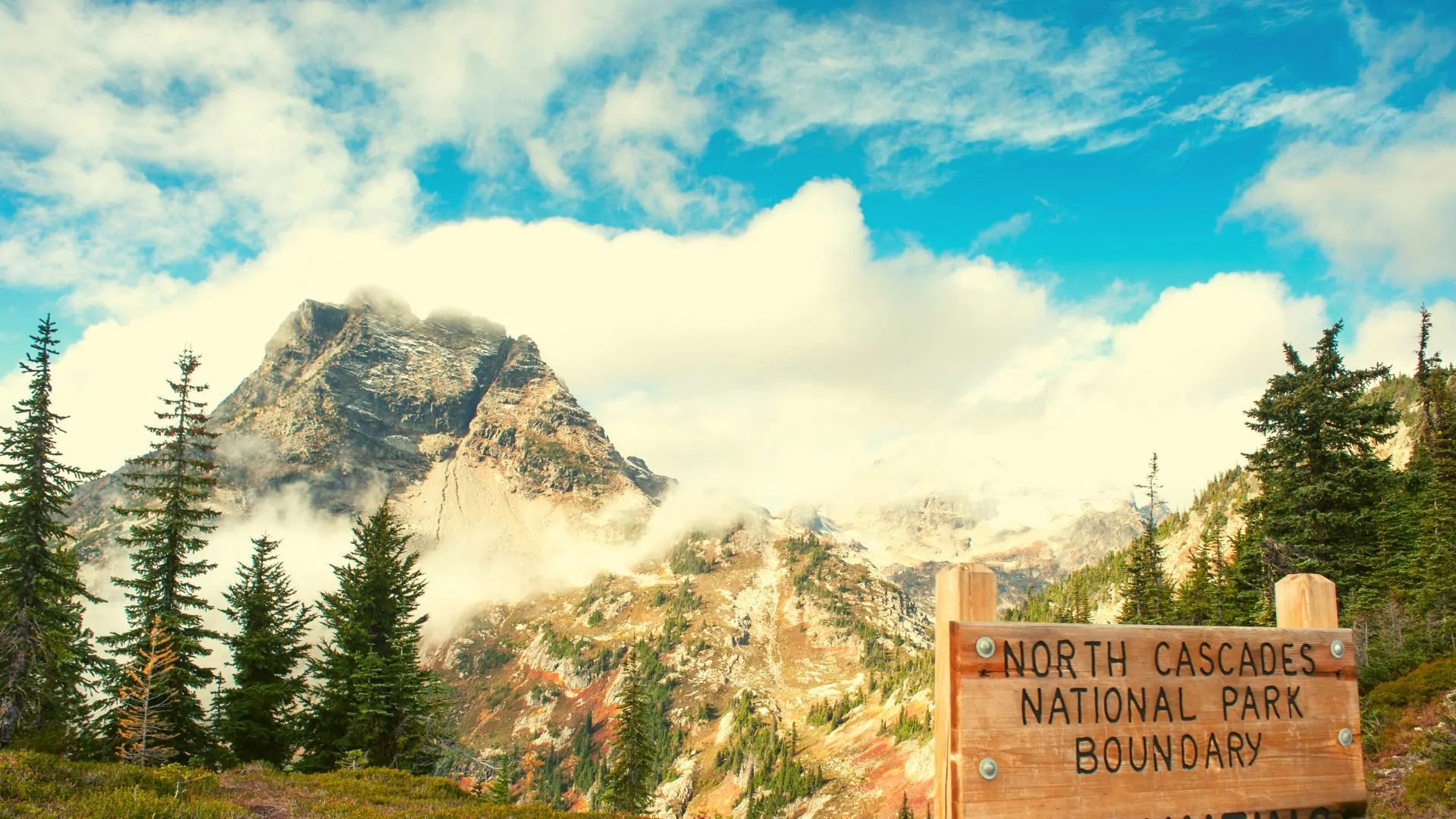North Cascades Camping and Backpacking

Stretching from the town of Wenatchee all the way to the Canadian Border, the North Cascade Range is home to rugged mountains, glacier-fed lakes, and bountiful Pacific Northwest rainforests filled with ferns and towering old-growth trees. This magnificent and vast wilderness area is often overlooked, despite being located just a short drive from the metropolitan center of Seattle. With ample wildlife, sightseeing, and recreation opportunities, North Cascades National Park is a great destination for day hikers, weekend warriors, and seasoned backpackers alike. Those with a night or more to spare in the area will enjoy some of the most picturesque campgrounds you can find.
Getting There
The easiest way to access the North Cascades is by car from the city of Seattle. From Seattle, you can take I-5 north to Burlington, and then take State Route 20 (also called the North Cascades Highway) east to the park. The North Cascades Highway is closed in winter due to snow, so check the Washington State Department of Transportation website for current road conditions and closures. Once you get to the North Cascades, there are several areas to explore, including North Cascades National Park, Ross Lake National Recreation Area, and Lake Chelan National Recreation Area. Each of these areas has its own entrances and visitor centers, so be sure to check park maps and websites for more information.
Need to Know:
Permits and Regulations
The North Cascades refers to the park and wilderness areas in North Central Washington and includes North Cascades National Park, Okanogan-Wenatchee National Forest, and Lake Chelan-Sawtooth Wilderness. Because this area and the following hikes are located within National Parks, National Forests, and Wilderness areas it is essential to be mindful of the permitting regulations.
While it is free to enter North Cascades National Park, it is a good idea to purchase an Annual Pass which allows access to all National Parks in the U.S., many of which require an entrance fee. Additionally, a Northwest Forest Pass is required for many areas and trailheads that are adjacent to the National Park boundary and can be purchased as a day pass for $5 or an annual pass for $30. Many travelers will stop in at the Marblemount Ranger Station where a Northwest Forest Pass and backcountry permits for camping in the wilderness can be obtained. Additionally, the rangers can check which campsites are available, and can make recommendations on trips to do based on the current trail conditions.
Best Times to Visit
The best time to visit the North Cascades is during the summer months of July, August, and September. During this time, the weather is generally sunny and warm, and the snow has melted making it easier to access the hiking trails and other outdoor activities. Wildflowers are also in full bloom during this time, making for beautiful scenery and sightseeing opportunities.
While less popular, the fall months of October and November are also a good time to visit the North Cascades, especially if you want to see the changing colors of the foliage. The crowds are smaller during this time, and the weather is still relatively mild. Be mindful that the highway closes seasonally each year once the road becomes too hazardous to drive, usually closing for good in late October and re-opening again in May.
Weather
The weather in the North Cascades can be unpredictable and challenging, especially during the shoulder-season months. Snow can occur at higher elevations even in the summer, and what may begin as a sunny, warm day can turn cold and stormy with little notice. That said, with adequate spare clothing, rain gear, and good planning, it is possible to recreate safely and enjoyably in a variety of weather conditions.
Wildlife
The North Cascades region is home to a rich and diverse array of wildlife, including many species that are considered rare or endangered, like bears, wolves, mountain goats, wolverines, and bald eagles. Though the likelihood of seeing a large predator is small, it is always a good idea to practice safe wildlife habits and Leave No Trace principles. This includes carrying bear spray with you on all hikes, packing out all of your trash, burying human waste properly, and not leaving any food or attractants unattended while camping overnight.
Guided or UnGuided
Many who travel to the North Cascades do so without a guide, however, it can be very beneficial to use a guiding service for a variety of reasons. Hiking with a guide can ensure that you are safe, especially in an area or trail you are unfamiliar with, and this becomes more important for overnight or remote trips in the backcountry. Furthermore is the convenience: guides will arrange all of the logistics necessary for your trip, including food, transportation, gear, and accommodations, leaving you free to enjoy the trip fully. In addition, using a guide means that all entrance fees, permits, and passes will be taken care of. Finally, local guides are able to provide natural history interpretation, teach skills, and impart experience and knowledge that are incredibly useful.
Guided Trips with wildland trekking
Best Front-Country Campsites
Colonial Creek
North Cascades National Park
As a first-time visitor to the North Cascades, Colonial Creek’s North and South campgrounds offer a fantastic launching point for many day hikes or activities in the area. It is situated on the shores of Diablo Lake and surrounded by beautiful mountains and dense forests, offering stunning views and plenty of opportunities for outdoor recreation. For those wanting to travel further afield, the Colonial Creek access cannot be beat. Connecting directly to many trail networks, the campgrounds are a popular place for backpackers to spend a night organizing gear and group logistics before setting out for the backcountry.
Colonial Creek North Campground is one of the larger, front-country campsites in the heart of the North Cascades, and is the perfect getaway for weekends or week-long trips. There are over 142 campsites in a variety of styles from car-camping, tent-only, and group sites, and amenities such as cooking facilities, fire rings, restrooms, showers, and RV hookups. Recreation opportunities available include fishing, kayaking, and paddleboarding, while the swimming area is perfect for a refreshing dip on a hot day.
Ross Lake Resort
North Cascades National Park
Ross Lake Resort is a family-owned, floating resort situated on the shore of Ross Lake. Only accessible by boat or by foot, this is a popular destination for those seeking peace and seclusion in the wilderness, and more amenities than drive-in or backcountry campsites offer. The resort has cabins, ranging from smaller cabins with a single room to larger cabins accommodating up to eight people. All cabins are fully equipped with anything you might need for a weekend getaway – just pack an overnight bag! The cabins do not have indoor plumbing but there is a tap outside of each, and the lakefront access is fantastic for swimming and lounging by the turquoise water.
The Ross Lake Resort also helps to operate a boat shuttle service, taking hikers to one of the 19 boat-in camps located along the shores of Ross Lake. While many are also accessible by hiking, the boat ride is a unique way to see the lake and surrounding mountains and can allow visitors to maximize their time exploring the area.
Best Backcountry Camping Areas
Cascade Pass Area
North Cascades National Park
This backcountry camping area is a must-see for any fanatic backpacker looking for the quintessential North Cascades experience. Starting from the Cascade Pass Trailhead is a lengthy, remote, and challenging network of trails through some of the most stunning scenery in the North Cascades with access to high-alpine peaks. This is a popular thru-hike, as it is possible to hike from East to West or vice-versa from the Cascade Pass Trailhead through to the Maple Pass trailhead – one of the premier multi-day hikes in the area.
Along the way there are many campsites to choose from, allowing hikers to do short overnight trips or multi-day excursions, with scenic day hikes interspersed along the way. Highlights include seeing the Boston Glacier – the largest in the North Cascades – as well as passing through expansive alpine meadows and alongside the Stehekin River. Visitors must obtain a permit to camp in this area and practice Leave No Trace principles to minimize their impact on the environment.
Ross Lake Area and the East Bank Trailhead
North Cascades National Park
It is impossible to drive through the North Cascades on Highway 20 without passing by the turquoise-blue waters of Ross Lake – a 23-mile lake that stretches from the heart of the mountains to the Canadian Border. While this is a frequent stop for sightseers and picture-takers, it also makes a great location for backpacking trips of all lengths. The East Bank Trail stretches north for over 30 miles, traversing alongside the lake with minimal elevation gain and over easily navigable and rolling terrain. With ample campsite options, most groups will take a leisurely 4-5 days to finish the trail at the north end of the lake, where hikers must catch a boat shuttle back to their vehicles.
Highlights include walking through old-growth forests alongside the lake, over creek beds full of meltwater from glaciers high above, and ample opportunity to see wildlife or cool off by swimming in the lake. This is a fantastic early-season hike as it remains at a lower elevation, and the trail may be clear of snow earlier in the year. It also makes a great hike for those newer to backpacking – with well setup campsites, relatively modest elevation gain, and easily navigable trails.
Thunder Creek Area
Where: North Cascades National Park
When there is still snow up higher, the area of Thunder Creek is one of our favorite early-season areas to go to in the North Cascades. Starting near the front-country campground of Colonial Creek, the Thunder Creek area offers the quintessential North Cascades hiking experience, traveling through lush cedar forests and alongside the green waters of glacier-fed creeks, offering up views of the peaks far above.
The Thunder Creek area is great for those newer to backpacking, and the trail is easy to follow, and well-maintained. Whether you are looking to hike a leisurely few miles and camp in the backcountry, or thru-hike its entire 38-mile length to Lake Chelan, there are dispersed campsites along its length to allow for any duration of the trip, and many popular side-hike opportunities to points of interest.
experience the best of the north cascades







